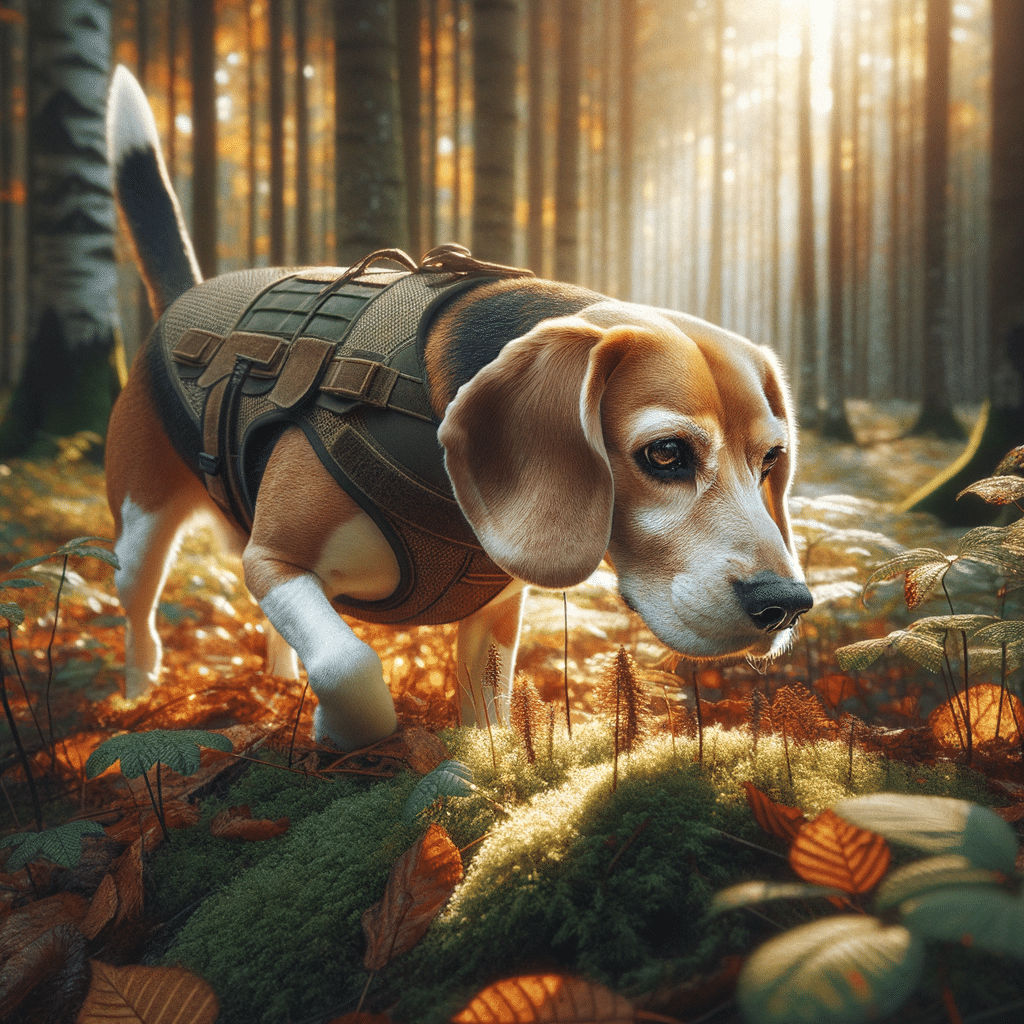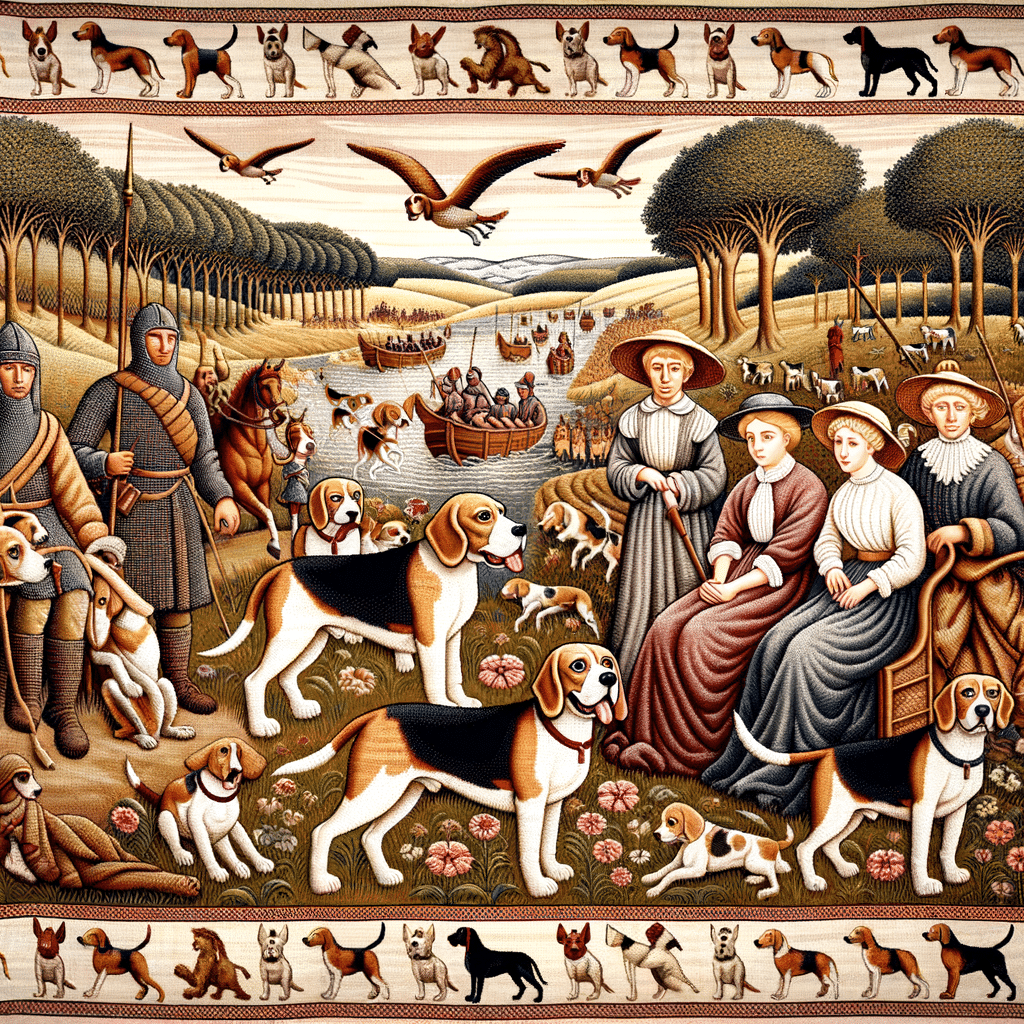The beagle is a delightful and popular dog breed known for a keen sense of smell and intelligent, friendly demeanor. Bred originally for hunting in England, they have a history that follows the evolution of tracking and hunting practices. Their small to medium size and acute sense of smell make them exceptional for hunting small game such as rabbits and hares.
In This Article
While their past is rooted in hunting, modern beagles have become beloved family pets, appreciated for their amiable and playful nature. They are adaptable and spirited, thriving in various living environments and bonding closely with their owners. Beagles require consistent dog training and care to harness their energy and inquisitive temperament.
Highlights
- Beagles are notable for their excellent sense of smell and stamina.
- They originally served as hunting dogs but have become affectionate family pets.
- Proper training and care are necessary to manage their energetic and curious personalities.
Origins and History
The beagle’s heritage traces back to ancient Greece. The breed evolved to become a proficient hunting companion greatly valued in England.
Ancestry
Beagles originated in ancient Greece, where similar hound breeds existed as early as the 5th century. Evidence suggests the breed’s development continued in medieval times in England, likely influenced by the arrival of Greek hunting dogs around 200 AD. These dogs may have been the foundation for numerous hound breeds that subsequently emerged, such as the Talbot hound and Southern hound.
Historical Significance
During the medieval period, beagles gained prominence in England. Due to their keen sense of smell, they excelled in hunting. They were bred to track small game animals like rabbits and hares.
Beagles have incredible stamina and a strong sense of smell, which led to their extensive use as a hunting staple. Queen Elizabeth I favored pocket beagles, an extinct miniature version of today’s beagle.
Physical Characteristics
The beagle is a breed with distinct physical traits that align closely with its origins as a proficient scent hound.
Size and Appearance
Beagles are compact, solid dogs recognized for their substantial bone structure and muscular build. They come in two sizes:
- 13-inch: Height at the withers is below 13 inches.
- 15-inch: Height at the withers ranges from 13 to 15 inches.
Typically, a beagle weighs between 18-30 pounds, corresponding to height and overall body structure.
Key physical features include:
- Floppy ears: Their long and droopy ears frame their face and enhance their keen sense of hearing.
- White-tipped tail: Often, a beagle's tail will have a white tip, also known as a "flag," which helps sight the dog when it lowers its nose to a scent trail.
Historical variants like the “pocket beagle” were bred for their smaller size, but this term is not used in contemporary breed standards.
Coat and Coloring
The beagle’s coat is a standout feature, fulfilling both functional and aesthetic roles. It is a double coat, which includes:
- Undercoat: Soft and fine for insulation.
- Topcoat: Coarser and denser to provide protection and repel moisture.
Beagles are often recognized for their tri-color pattern, which typically combines black, white, and tan. However, they may come in any “true hound color,” according to breed standards, which include black, white, tan, brown, red, and lemon.
Various patterns such as ticking, freckling, and large patches may also be present. Potential owners should note that the breed’s short coat requires minimal grooming and is easy to maintain.
Temperament and Behavior
Beagles are widely recognized for their even temperament and sociable nature, making them excellent family pets. They exhibit a unique blend of energy, curiosity, and a desire for companionship.
Personality Traits
Beagles are affable and good with children. They often display a playful attitude, making them beloved companions in many households. They thrive on human interaction and are known to form strong bonds with their family members.
Here are some of their key personality traits:
- Determined: They enthusiastically see it through once they pick up a scent or start a task.
- Energetic: They possess significant stamina and require regular exercise to avoid becoming restless.
- Loyal: Beagles tend to be devoted to their owners and are often eager to please.
Behavioral Tendencies
Regarding behavior, the beagle’s notable traits include being vocal and active. Their vocalizations range from barking to howling, a form of communication from their hunting heritage.
Beagles have high energy levels that should be managed through play and exercise. This breed requires daily exercise to manage their energy levels‚ ideally engaging in playtimes or walks.
Beagles are often friendly towards strangers, showing a welcoming and curious disposition. Their temperament makes them less suitable as guard dogs but excellent as social pets.
Training and Care
Beagles are known for their intelligence and enthusiasm but require consistent training and care to maintain their well-being. Proper mental stimulation and grooming are critical for a healthy, well-adjusted pet.
Training Needs
Beagles respond best to positive reinforcement techniques. Training should be started early, focusing on basic commands and obedience. They possess a strong sense of smell and may easily be distracted by scents, so patience and persistence are essential during training sessions.
Beagles require ample mental stimulation, which can be provided through:
- Interactive toys and puzzles to keep their minds engaged.
- Regular exercise to help prevent obesity, a common issue if dietary intake is not managed.
Health and Grooming
Regular grooming is necessary to manage beagle shedding. Beagles should be brushed at least once weekly to reduce shedding and distribute natural oil content across their fur. They should be bathed monthly or as needed to keep odors at bay.
Health care for beagles involves proactive monitoring for signs of genetic health problems common to the breed, such as hip dysplasia or hypothyroidism. A balanced diet and consistent exercise are core to preventing obesity.
Here are additional care tips:
- Chewing: Provide durable chew toys since beagles can be aggressive chewers.
- Anal glands: Beagles may require their anal glands to be checked regularly to prevent issues.
- Worming: Regular treatment should be maintained according to veterinary advice.
Maintaining consistent health check-ups, grooming, and training routines will ensure optimal dog health and happiness.
Role in Society
The beagle has held significant societal roles ranging from hunting to security.
Working Roles
- Hunting dog: Traditionally bred to hunt small game, the beagle is considered an expert hunting companion. The breed is a scent hound, possessing an acute sense of smell and a strong instinct for tracking. Hunters have relied on beagles for their stamina and sound, making them ideal for hunting rabbits and hares.
- Beagle Brigade: A specialized group of beagles, the Beagle Brigade operates under the U.S. Department of Homeland Security. These working dogs serve as agricultural detection dogs, using their keen sense of smell to detect prohibited and potentially harmful foods, plants, and animal products at U.S. borders.
- Detection dogs: Apart from their role in border security, beagles have been trained for various detection tasks. Their highly developed scent receptors enable them to work as bedbug detectors and even detect polar bears' pregnancies in zoological environments.
Cultural Significance
- Peanuts: Snoopy, the iconic dog from the comic strip "Peanuts," is likely the most famous beagle, significantly shaping public perception of the breed. Snoopy's character showcases the intelligence, independence, and loyalty that beagles are known for.
- Presidential pets: Beagles have also made their mark on the White House. President Lyndon Johnson owned multiple beagles during his presidency, including a dog named Edgar, bringing further prominence to the breed.
- Pop culture: Beyond Snoopy, beagles have appeared in various media, from movies to literature, often portrayed as friendly and approachable companions. Elvis Presley famously owned a beagle.
Frequently Asked Questions
Beagle enthusiasts often ask about the breed’s diet, personality, size, varieties, hunting capabilities, and what makes them unique. Here are answers to some of the most common questions.
What is the typical diet for a beagle?
Beagles do well on a balanced diet of high-quality dog food, which can be commercially manufactured or home-prepared with a veterinarian’s oversight. Given their propensity for obesity, it’s essential to monitor their calorie consumption and weight.
What are some charming personality traits of beagles?
Beagles are known for their friendly and curious nature. They are generally affable dogs with a propensity for companionship, making them great family pets. They often display a joyful demeanor and eagerness for play.
How much does an average beagle weigh?
An average beagle weighs 20 to 30 pounds (9 to 13.5 kilograms) and is classified into two size categories: those under 13 inches at their shoulder and those between 13 and 15 inches.
Can you list the different varieties of beagles?
Beagles are commonly divided into two types based on their size: the smaller variety stands at about 13 inches tall or under, while the standard variety grows between 13 and 15 inches tall.
What sort of prey do beagles commonly hunt?
Beagles were bred to hunt small game, primarily rabbits and hares. Their keen sense of smell and stamina equip them well for tracking and hunting these types of prey.
Why are beagles considered a unique breed?
Beagles possess an exceptional sense of smell, only second to the Bloodhound among dog breeds, which makes them excellent scent trackers. Their history as hunting dogs and friendly personality contribute to their uniqueness as a breed.






